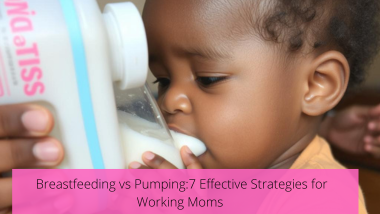
Breastfeeding vs pumping: which option is best for your schedule as a working mom? For many mothers, choosing whether to pump or breastfeed feels like a monumental decision. Each option offers advantages and disadvantages, impacting your schedule, milk supply, and overall parenting experience.
Understanding these key facts about breastfeeding vs pumping can help you determine which method aligns best with your lifestyle. This is especially important as a working mom balancing a career and family responsibilities. Knowing the pros and cons of breastfeeding vs pumping will empower you to make an informed decision.
1. The Basics of Breastfeeding vs Pumping
Breastfeeding
Breastfeeding involves directly feeding a baby at the breast. It’s praised for its emotional bonding benefits and nutritional advantages. Mothers provide their babies with essential nutrients and antibodies for growth and development.
The experience fosters a unique connection, allowing for skin-to-skin contact. This intimacy enhances the emotional bond between mother and child and can create lasting memories during those early feeding sessions.
Pumping
Pumping allows mothers to express and store breastmilk for later use. This method provides flexibility for those returning to work or unable to breastfeed directly. With the right equipment, mothers can maintain their milk supply while away from their babies.
Pumping also ensures that your baby receives the nutritional benefits of breastmilk, especially important when you’re not physically present. It’s a practical solution for many working mothers, emphasizing the benefits of pumping in the breastfeeding vs pumping conversation.
2. Scheduling for Success in Breastfeeding vs Pumping
Finding a breastfeeding and pumping routine that fits your lifestyle is crucial. A typical schedule for working moms may include breastfeeding first thing in the morning. This helps build your milk supply and provides a bonding experience to start your day.
During work, aim to pump every 3-4 hours, aligning with your baby’s feeding schedule. For an 8-hour workday, plan for two to three pumping sessions. Make sure to factor in the time for setup and cleaning your breast pump.
Example Schedule:
- Morning Pump: 10 a.m. (around 3 hours after your morning breastfeeding)
- Lunch Pump: 1 p.m. (during your lunch break)
- Afternoon Pump: 4 p.m. (before heading home)
After work, reconnect with your baby by breastfeeding immediately upon returning home. This is a great time for bonding after a long day at work. Depending on your baby’s needs, consider breastfeeding before bed and during the night if they wake up hungry.
3. Advantages of Breastfeeding
Bonding Experience
Breastfeeding fosters a deep emotional connection through skin-to-skin contact. This intimacy promotes the release of oxytocin, often referred to as the “love hormone,” enhancing your emotional well-being as a mother. This significant benefit highlights the value of breastfeeding in the breastfeeding vs pumping discussion.
Nutritional Benefits
Breastfeeding provides optimal nutrition tailored to your baby’s needs. Breastmilk contains a perfect balance of fats, proteins, and carbohydrates. It also has antibodies that help protect against illnesses, making breastfeeding a crucial consideration in the breastfeeding vs pumping debate.
Convenience
No equipment is needed for breastfeeding; simply feed your baby when they’re hungry. This makes breastfeeding especially convenient when you’re at home. You won’t have to worry about purchasing or maintaining a breast pump, bottles, or storage bags.
Stimulates Milk Production
Nursing directly at the breast tends to stimulate milk production more effectively than pumping. The more your baby feeds, the more milk supply you create, ensuring you produce enough milk for your baby, which is a significant advantage of breastfeeding in the breastfeeding vs pumping comparison.
4. Disadvantages of Breastfeeding
Time Commitment
Breastfeeding requires you to be physically present for each feeding. This can be challenging when managing work obligations, leading to feelings of being tied down when trying to juggle commitments.
Physical Exhaustion
Frequent feedings can lead to fatigue, especially for new mothers managing nighttime feedings. This exhaustion can impact your overall well-being and your ability to perform at work.
Challenges with Latching
Some babies may struggle to latch properly, which can be painful for the mother. This may require additional support or lactation consultation, adding complexity to your breastfeeding journey.
Social Limitations
Some mothers may feel uncomfortable breastfeeding in public or struggle to find private spaces. This can lead to feelings of isolation or anxiety about feeding in social situations, highlighting the challenges some may face in the breastfeeding vs pumping decision.
5. Advantages of Pumping

Flexibility and Freedom
Pumping allows you to store breastmilk for later use, giving you flexibility. This is especially beneficial for moms returning to work or with social commitments, ensuring your baby is fed even when you’re not present.
Shared Responsibilities
Pumping enables partners and other caregivers to participate in feedings, promoting bonding while allowing the mother a break. Shared responsibility can help relieve some pressure on the mother, making pumping an attractive option in the breastfeeding vs pumping debate.
Feeding on a Schedule
Pumping allows you to create a feeding schedule that suits your lifestyle. This ensures that your baby gets their required nutrition at consistent times. Predictability can help you manage both your work and family life effectively.
Pumped Milk for Emergencies
Having a stock of pumped milk can be beneficial in emergencies. It can also help when you need to take medication not safe for breastfeeding. This ensures that your baby still receives the nutritional benefits of breastmilk, reinforcing the practical aspects of pumping in the breastfeeding vs pumping discussion.
6. Disadvantages of Pumping vs Breastfeeding
Time-Consuming
Pumping can be a lengthy process, including cleaning the equipment and storing milk. This can take away precious time you could spend with your baby, making time management crucial for working mothers.
Lower Milk Production for Some
Some mothers find that pumping doesn’t stimulate milk production as effectively as breastfeeding. This may lead to a possible decrease in milk supply over time, making it essential to monitor your production levels and adjust your routine accordingly.
Need for Equipment
Pumping requires a good breast pump and storage containers, which can be a financial and logistical burden for many mothers. Carrying the pump and ensuring everything is clean can be cumbersome.
Less Bonding
Pumping can reduce the amount of skin-to-skin contact and bonding time, potentially affecting your emotional connection with your baby. Maintaining this bond is especially important in the early months and is a notable disadvantage in the breastfeeding vs pumping comparison.
7. Practical Tips for Balancing Breastfeeding vs Pumping
Successfully balancing both breastfeeding and pumping requires a well-thought-out plan. Establish a pumping schedule when you return to work, aiming to pump at the same times your baby would normally eat to maintain your milk supply.
Find a Comfortable Space
Ensure your workplace has a private and clean area for you to pump. Comfort can significantly impact your ability to express milk effectively, so discussing your needs with your employer can help create a supportive environment.
Invest in Quality Equipment
Choose a reliable breast pump that fits your lifestyle. A double electric breast pump is often recommended for efficiency. Don’t forget to have extra parts on hand in case something breaks or needs to be cleaned.
Breastfeed When Home
Breastfeed your baby when you’re home, especially in the morning and evening. This maintains the bond and ensures your baby is getting enough milk. This routine can provide comfort for both you and your baby.
Prepare Ahead of Time
Have everything you need for pumping organized each day. Include your breast pump, bottles, and storage bags in your preparation. This can save you time and stress during your workday.
Communicate with Your Employer
If possible, inform your employer about your needs as a breastfeeding or pumping mother. This can help ensure you have a supportive environment, possibly leading to accommodations like a dedicated pumping area or flexible break times.
Stay Hydrated and Nourished
Ensure you’re drinking enough fluids and eating well to support your milk supply. A well-balanced diet will benefit both your health and your ability to produce milk, which is vital during this demanding time.
Conclusion: Making the Best Choice in Breastfeeding vs Pumping
Choosing between breastfeeding and pumping is a deeply personal decision influenced by your lifestyle, preferences, and circumstances. Each method has distinct pros and cons that you should understand.
Whether you opt for breastfeeding, pumping, or a combination of both, your baby’s nutrition and your well-being are paramount. With careful planning and support, you can find a routine that works for you. This rewarding journey can be both manageable and fulfilling.
Share your experiences, tips, and questions in the comments below!


